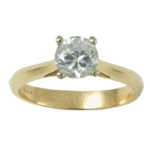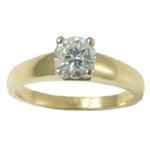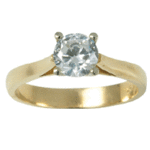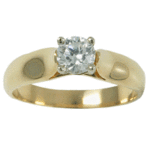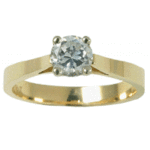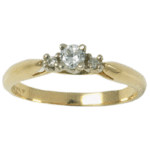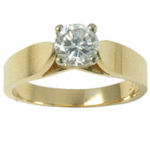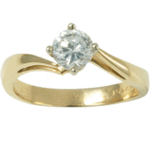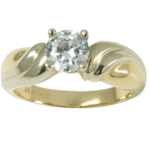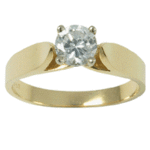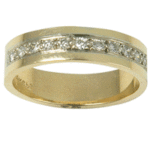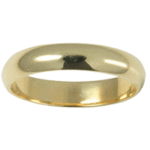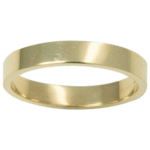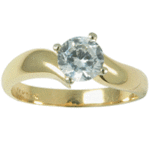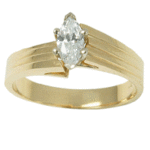Once you have decided that you will be purchasing the diamond the next step of course is to have the diamond mounted in a setting. The setting for the diamond is very important. It should be strong and durable for everyday wear. The setting or mount should protect the diamond as well. 14kt. yellow or white gold is a hard, durable gold that is sufficient for everyday wear. 14kt. gold means that 14/24 or 58.5% or 585 parts per 1000 of the metal is pure gold and the other parts of the metal are alloys. In yellow gold the two main alloys are copper and silver. The more copper the more pinkish the gold is and the less copper the more yellowish the gold is. White gold contains nickel and silver as alloys. Not only does the nickel harden the gold but it also gives the gold the white colour. I recommend making up the ring with white gold claws to hold the diamond as the white gold claws are harder than yellow gold claws and also, the light reflecting off the white gold claws and going back into the diamond will not darken or turn the diamond more yellowish as the yellow claws would.
18kt. gold or 18/24 or 75% or 750 parts per 1000 gold is also a recommended gold to use. 18kt. gold comes in either white or yellow gold again depending upon the alloys used to make the gold. Since 18kt. is more of a pure gold it is heavier and a bit softer, however, for a ring it is fine. Please understand that 18kt. gold is softer and will dent easier and the edges seem to round out or smoothen down quicker, however, it is sufficiently hard enough for a ring. 18kt. yellow gold seems to have a deeper, richer lustre that blends in very nicely with diamonds. In countries such as Italy, France and Switzerland most of the fine quality jewellery is in 18kt. gold. I personally prefer 18kt. gold and would pay the extra amount involved to have an 18kt. gold mount. Remember, though that the 14kt. gold is harder and more durable. The choice is yours and with either using 14kt. or 18kt. you can’t go wrong.
There are six platinum metals referred to as the platinum group. The three platinum metals of interest are platinum, palladium and rhodium. Platinum is a possibility for your ring. Platinum, hardened by iridium and ruthenium, is very strong and highly ductile and thus makes a very safe setting for diamonds. With platinum it is possible to make smaller claws and beads and therefore a more dainty, delicate and lighter ring can be made than can be with white gold. A platinum mount can be two to three times as expensive as an 18kt. white gold mount. Platinum only comes in the white colour.
I recommend that you keep the actual setting very simple and make sure that the setting does not take away from the main diamond. I believe that the setting should highlight and enhance the main diamond and not detract from it. As well, shoulder diamonds should not take away from the main diamond but should nicely frame and add to the main diamond.
The shoulder diamonds should match the main diamond in quality. Keep the colour and clarity of all the shoulder diamonds the same or higher than the main diamond. It is usually best for the jeweller or goldsmith making up the mount to supply the shoulder diamonds as he knows the exact measurements to supply. Baguette diamonds chip easily when set so have the gemmologist check for this in your final appraisal of the ring.
Most solitaire engagement rings are cast made by casting gold in plaster molds. The plaster mold is placed in a centrifuge and as it whirls about in a fine arc the molten precious metal is transferred into the cavity of the plaster mold. The molten gold or platinum is thrown with great pressure into every detailed crevice of the mold. Due to the fine texture of rubber and plaster molds no texture distortion occurs in the casting which results in accuracy of fine detail. The plaster mold can only be used once while the rubber mold can be used to make hundreds of wax models. The final result is an extremely accurate reproduction of the original metal master model.
The cost on a cast engagement ring could vary from as low as approx. $150 CDN to approx. $500 CDN for a very fine quality cast ring in 14kt. yellow gold. The price to a large extent depends on the weight of the ring.
Custom designed handmade rings are the most expensive and can easily run from around $400 CDN to approx. $1200 CDN. You may want to commission a custom goldsmith to design and create a uniquely styled custom designed ring that no one else has. Be sure to get some recommendations and speak to previous clients who had their rings made by a particular goldsmith. Make sure to view some of the rings that the goldsmith made in the past. If a goldsmith custom designs a ring especially for you make sure that once you have your ring the goldsmith will not produce the same ring for other clients. You don’t want to see your friends wearing the ring that you or your goldsmith custom designed for yourself. You should have some type of agreement with the goldsmith or jeweller.
The diamond must be securely set in the setting. A bezel setting completely surrounds the edge or border of the diamond with gold and thus makes the diamond very secure. One disadvantage though, of a bezel setting, is that the yellow gold surrounding the diamond will tend to make the diamond appear more yellow. Also, bezel set diamonds are harder to clean. Also, a bezel set diamond will tend to look a little smaller while in the setting.
Most claw settings are quite secure. The claws should be in white gold. A 4-claw white gold will show more of the diamond than a circular 6-claw white gold setting. A diamond set in a claw setting could always fall out if one of the claws were bent backwards or became disengaged or became snagged. That’s why an all risk type of insurance policy for a diamond ring is so important!
When leaving the diamond with a jeweller or goldsmith, especially with someone different than the jeweller from whom you purchased the diamond, it is a good idea to have the goldsmith or jeweller acknowledge by way of a signature that it matches the diamond inclusion plot on the original appraisal. He could also acknowledge the fact that is has been laser gemprinted.
Be careful once you leave the diamond with another goldsmith or jeweller other than the original one who sold you the diamond. Clarify with the jeweller or goldsmith who is making up the ring for you what would happen in the event that the diamond were stolen or damaged while left on his premises or in his possession. TRY AND GET THE MAXIMUM PROTECTION FOR YOURSELF. YOU MAY WANT TO CONSULT WITH YOUR INSURANCE AGENT AND A LAWYER IN REGARDS TO THESE MATTERS.

